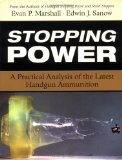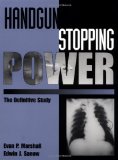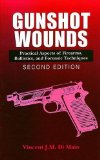Ballistics Coefficient is the ratio of a bullets Sectional Density to its coefficient of form.
Coefficient of form is a number which describes a bullets shape.
Ballistics Coefficient is important because, all other variables being equal, a bullet with a higher Ballistics Coefficient will:
- Lose less energy and speed in flight
- Drop less on the way to the target
- Penetrate more effectively into a target
Ballistics Coefficient is abbreviated BC.
Books on Ballistics and Ammunition

Stopping Power: A Practical Analysis of the Latest Handgun Ammunition
Evan Marshall and Ed Sanow rocked the firearms world with the release of HandgunStopping Power and Street Stoppers. Both books predicted the effectiveness of all types of ammunition by studying the results of real-life shootings rather than relying on laboratory tests that ignored the dynamics of an actual gunfight. This third book in the series provides the very latest street results of all the major handgun calibers, from .22 LR to .45 ACP, as well as popular rifle and shotgun loads. It also contains chapters on short-barrel ballistics, the emergence of the hot new .357 SIG caliber, the continued success of the .40 S&W, the development of the latest exotic ammo, the effectiveness of black powder firearms and a brand-new ammo test protocol based on the results of the many gunfights of U.S. Border Patrol officers.

Handgun Stopping Power : The Definitive Study
Dramatic first-hand accounts of the results of handgun rounds fired into criminals by cops, storeowners, cabbies and others are the heart and soul of this long-awaitedbook. This is the definitive methodology for predicting the stopping power of handgunloads, the first to take into account what really happens when a bullet meets a man.

Gunshot Wounds: Practical Aspects of Firearms, Ballistics, and Forensic Techniques, Second Edition
Written by the nation’s foremost authority on gunshot wounds and forensic techniques as they relate to firearm injuries, Gunshot Wounds: Practical Aspects of Firearms, Ballistics, and Forensic Techniques, Second Edition provides critical information on gunshot wounds and the weapons and ammunition used to inflict them. The book describes practical aspects of ballistics, wound ballistics, and the classification of various wounds caused by handguns, bang guns, rifles, and shotguns. The final chapters explain autopsy technique and procedure and laboratory analysis relating to weapons and gunshot evidence.
